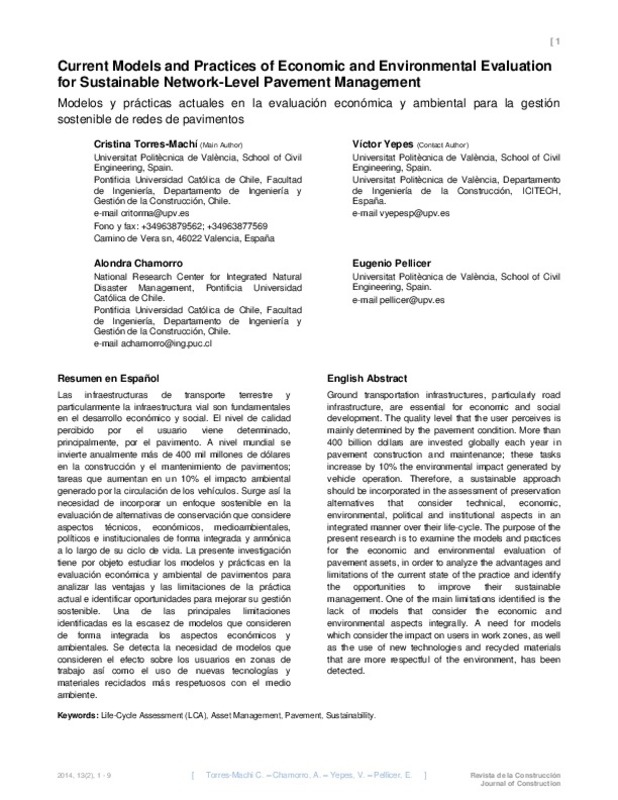JavaScript is disabled for your browser. Some features of this site may not work without it.
Buscar en RiuNet
Listar
Mi cuenta
Estadísticas
Ayuda RiuNet
Admin. UPV
Current Models and Practices of Economic and Environmental Evaluation for Sustainable Network-Level Pavement Management
Mostrar el registro sencillo del ítem
Ficheros en el ítem
| dc.contributor.author | Torres Machí, Cristina
|
es_ES |
| dc.contributor.author | Chamorro, Alondra
|
es_ES |
| dc.contributor.author | Yepes, V.
|
es_ES |
| dc.contributor.author | Pellicer Armiñana, Eugenio
|
|
| dc.date.accessioned | 2015-10-05T12:18:13Z | |
| dc.date.available | 2015-10-05T12:18:13Z | |
| dc.date.issued | 2014-08 | |
| dc.identifier.issn | 0718-915X | |
| dc.identifier.uri | http://hdl.handle.net/10251/55539 | |
| dc.description.abstract | [EN] Ground transportation infrastructures, particularly road infrastructure, are essential for economic and social development. The quality level that the user perceives is mainly determined by the pavement condition. More than 400 billion dollars are invested globally each year in pavement construction and maintenance; these tasks increase by 10% the environmental impact generated by vehicle operation. Therefore, a sustainable approach should be incorporated in the assessment of preservation alternatives that consider technical, economic, environmental, political and institutional aspects in an integrated manner over their life-cycle. The purpose of the present research is to examine the models and practices for the economic and environmental evaluation of pavement assets, in order to analyze the advantages and limitations of the current state of the practice and identify the opportunities to improve their sustainable management. One of the main limitations identified is the lack of models that consider the economic and environmental aspects integrally. A need for models which consider the impact on users in work zones, as well as the use of new technologies and recycled materials that are more respectful of the environment, has been detected. | es_ES |
| dc.description.abstract | [ES] Las infraestructuras de transporte terrestre y particularmente la infraestructura vial son fundamentales en el desarrollo económico y social. El nivel de calidad percibido por el usuario viene determinado, principalmente, por el pavimento. A nivel mundial se invierte anualmente más de 400 mil millones de dólares en la construcción y el mantenimiento de pavimentos; tareas que aumentan en un 10% el impacto ambiental generado por la circulación de los vehículos. Surge así la necesidad de incorporar un enfoque sostenible en la evaluación de alternativas de conservación que considere aspectos técnicos, económicos, medioambientales, políticos e institucionales de forma integrada y armónica a lo largo de su ciclo de vida. La presente investigación tiene por objeto estudiar los modelos y prácticas en la evaluación económica y ambiental de pavimentos para analizar las ventajas y las limitaciones de la práctica actual e identificar oportunidades para mejorar su gestión sostenible. Una de las principales limitaciones identificadas es la escasez de modelos que consideren de forma integrada los aspectos económicos y ambientales. Se detecta la necesidad de modelos que consideren el efecto sobre los usuarios en zonas de trabajo así como el uso de nuevas tecnologías y materiales reciclados más respetuosos con el medio ambiente. | |
| dc.description.sponsorship | Authors gratefully acknowledge members of the research group at the Pontificia Universidad Católica de Chile for their resources during the study. The research team acknowledges Fondef/Conicyt 2009 for funding the project “Research and Development of Solutions for Urban Pavement Management in Chile” (D09I1018) and the National Research Center for Integrated Natural Disaster Management CONICYT/FONDAP/15110017. Funding over Conicyt (CONICYT-PCHA/Doctorado Nacional/2013-63130138) to support this work is sincerely appreciated.. | |
| dc.language | Español | es_ES |
| dc.relation.ispartof | Revista de la Construcción | es_ES |
| dc.rights | Reconocimiento (by) | es_ES |
| dc.subject | Asset management | es_ES |
| dc.subject | Life-cycle assessment | es_ES |
| dc.subject | Pavement | es_ES |
| dc.subject | Sustainability | es_ES |
| dc.subject.classification | PROYECTOS DE INGENIERIA | es_ES |
| dc.subject.classification | INGENIERIA DE LA CONSTRUCCION | es_ES |
| dc.title | Current Models and Practices of Economic and Environmental Evaluation for Sustainable Network-Level Pavement Management | es_ES |
| dc.title.alternative | Modelos y prácticas actuales en la evaluación económica y ambiental para la gestión sostenible de redes de pavimentos | |
| dc.type | Artículo | es_ES |
| dc.relation.projectID | info:eu-repo/grantAgreement/FONDEF//D09I1018/CL/Investigación y Desarrollo de Soluciones a la Gestión de Pavimentos Urbanos en Chile/ | es_ES |
| dc.relation.projectID | info:eu-repo/grantAgreement/CONICYT//15110017/ | es_ES |
| dc.relation.projectID | info:eu-repo/grantAgreement/CONICYT//2013-63130138/ | es_ES |
| dc.rights.accessRights | Abierto | es_ES |
| dc.contributor.affiliation | Universitat Politècnica de València. Departamento de Ingeniería de la Construcción y de Proyectos de Ingeniería Civil - Departament d'Enginyeria de la Construcció i de Projectes d'Enginyeria Civil | es_ES |
| dc.description.bibliographicCitation | Torres Machí, C.; Chamorro, A.; Yepes, V.; Pellicer Armiñana, E. (2014). Current Models and Practices of Economic and Environmental Evaluation for Sustainable Network-Level Pavement Management. Revista de la Construcción. 13(2):49-56. http://hdl.handle.net/10251/55539 | es_ES |
| dc.description.accrualMethod | S | es_ES |
| dc.relation.publisherversion | http://rdlc.alerta.cl/index.php/rdlc/issue/archive | es_ES |
| dc.description.upvformatpinicio | 49 | es_ES |
| dc.description.upvformatpfin | 56 | es_ES |
| dc.type.version | info:eu-repo/semantics/publishedVersion | es_ES |
| dc.description.volume | 13 | es_ES |
| dc.description.issue | 2 | es_ES |
| dc.relation.senia | 276308 | es_ES |
| dc.contributor.funder | Comisión Nacional de Investigación Científica y Tecnológica, Chile | |
| dc.contributor.funder | Fondo Nacional de Desarrollo Científico y Tecnológico, Chile |






